Highly regarded Landscape Architect, Bloom gold medal winner, Patricia Tyrrell reports in from Bloom 2019 and wonders where the future lies
I’ve always liked the eighties pop-band, Talking Heads. During my recent participation in the design and construction of a Bloom show garden, the words to their song, Once in a Lifetime, kept running through my head. The song is about life. About the way we can drift along in its current, only surfacing occasionally to see clearly where we are and what we are doing with our lives.
Designing and building a Bloom show garden is like being caught in a current. Months of thought and preparation, weeks on-site, building intensively, with all the stress, pressure and exhaustion. It consumes you, carries you along. You finally surface as the final touches are put to your garden only to submerge once again… judging, the media, the public, your actual life, your actual job: It’s exhausting. You briefly come up for air as the show closes, then back under during the garden take-down. Eventually, you resurface proper and you wonder why?
SO WHY DO DESIGNERS DO IT?
Well, it’s complicated and it’s most certainly not about medals and accolades as many people might think. It is about the experience. For example, entering with the students of horticulture at Cabra Community College, it was all about tangibly experiencing the design and build process in real life. To translate abstract learning into something real and doing it as part of a team. This sense of team spirit, of comradery, of community and shared experience, is such a part of the Bloom build. You make new friends, share tools, advice, tents, cake, help each other out. It is buoyancy, which keeps us all from succumbing to the intense current of the build period.
THE CREATIVE PROCESS
Designers do it because it is an intensely creative process. A compressed, exhilarating and addictive act of creation that draws designers into a flow state. That magical state of presentness, where time is warped, and you are fully engaged. There is a huge satisfaction in seeing what you visualised in your head and on paper appear on the ground. Each new delivery is another piece in the puzzle. The planting is like a fascinating conversation, where the words can be arranged, or adjusted to better make the meaning understood.
IT IS A LEARNING EXPERIENCE
Designers do it as it helps to sharpen skills and provides an opportunity to reaffirm design understanding. The underpinnings of design are brought out into the light for all to see. Elements and principles are dusted off, honed, refined and you’re reminded why you followed this path in the first place. Show gardens are often the result of months or years of research. They can have a depth and meaning far deeper than your day to day practice. Engaging with this depth is immensely rewarding.
MEDALS AND ACCOLADES
As mentioned, designers don’t do it for medals and accolades. That noted, they are an important element in the wider picture: but they’re not everything. What’s more important than medals is what the designer does with them. How do they market and promote themselves, their skills and the wonderful gardens they have built? Of course, the larger garden categories are more prestigious, and promotion is easier. The media tend to broadcast from these gardens and they make the papers and the presidential visits.
Smaller gardens are harder to promote through these outlets as they get less media focus. This has become more apparent over the last few years. There seems to be far less emphasis on smaller garden spaces. This should be looked at by the organisers.
MESSAGES
Designers do it to communicate. Oftentimes designers are frustrated artists; whose medium is garden space. As such, they can desire to express ideas, feelings and thoughts. Show gardens can be a great way to do is. Particularly if you have artistic free reign. The practical reality of design work for real clients in real sites is that you often have limited opportunities for truly creative expression. Bloom can allow you to be your own client. This is wonderfully rewarding, but also challenging.
Increasingly, Bloom show gardens are being used as tools to communicate messages from corporate sponsors to charity organisations. In my opinion, this has produced mixed results. Design quality and integrity have been sacrificed for sponsor messages.
Three of the gardens – my own included – were created by education institutions: UCD, Trinity and Cabra Community College. Fingal County Council also designed a garden, something they have done for the last few years. Their Bee Positive Garden was part of an endeavour to educate the public and particularly children about pollinator-friendly plants and gardens. There is also the Supergarden sponsored by Woodies, where the winner of the television competition gets to build a garden at Bloom.
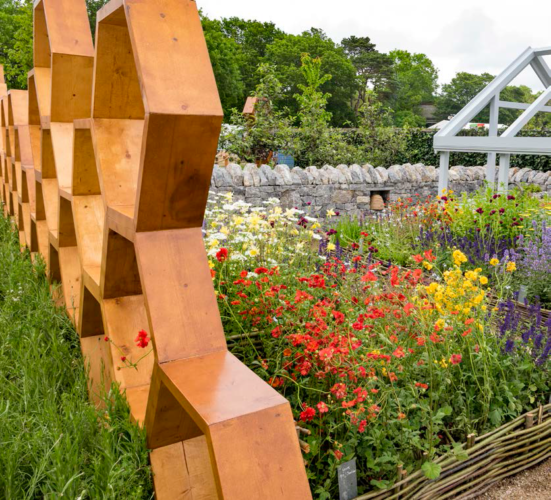
THE WIDER PERSPECTIVE
While I find myself trying to articulate why designers do it, when I look at the line up over the last few years I am really wondering where have the designers gone. I mean, if you took away the message gardens and the education institutions, how many actual designers are really creating gardens. Very few it would seem. Is it time for a rethink, for the Bloom organisers to make it more attractive to the design community? I think so.
SO HOW DO WE GET THE DESIGNERS BACK
Is it time to be more creative with media?
Perhaps instead of Supergarden we should have Showgarden – following the trials and triumphs of designers as they journey through their build. It would certainly be a more realistic education for the public on what’s involved in the construction of a garden and give extra exposure to the designers. Initial viewing of the early stages could be aired as a teaser pre-Bloom and the final part of the Build and the medals post-Bloom. Sourcing of plants and materials could be a really interesting aspect of this program and allow for more interconnectedness with nurseries and suppliers.
PERHAPS IT’S TIME FOR NEW JUDGES AND A LITTLE GENDER BALANCE?
If you do the same job for 13 years it can be difficult to be as enthusiastic as you were at the beginning. I imagine that going through the designs must be very much like being a design studio tutor, where for each students design you have to put a lot of energy into first understanding the brief, then understanding the ideas and concept of the design and finally clearly articulating why a particular design element works or doesn’t. After a couple of years, this must get a little difficult to be enthusiastic about, so perhaps there should be more rotation in the judging panel. Perhaps also there should be some more female judges. Six judges, only one of whom has been female in the last 13 years seems a little unbalanced to me. There are just as many excellent female garden designers as male making an impact in the UK and Europe today.
PERHAPS IT’S TIME FOR NEW CATEGORIES?
The show gardens fall into small medium and large. It can be all a little dry and humourless. Could some new categories inspire more interest and inspiration? A garden inspired by art or literature perhaps or inspired by a particular person? What would Borris Johnson’s Garden look like for instance, or David Attenborough’s? Or just a really witty whimsical garden, based on a person of the designers choosing.
PERHAPS IT’S TIME TO REFOCUS ON ACTUAL GARDENS RATHER THAN MESSAGES?
Many designers might say plants are at the forefront of what they do but actually it is people. How the client uses and enjoys a garden underpins our designs. The design itself can be conceptual, but we will return to this layer of the design constantly to ensure it is just right. Purely conceptual builds for sponsors, sometimes cause designers to get lost in the concept, and without a physical user of the space, it can lose this vital aspect. A garden should always have an owner, someone to enjoy the space and its features. Without this, there can be very little for the show visitor to relate to or to take home.
Sponsors should be more willing to step back and let the designer create a garden with a real wow factor, which will do the marketing for them, rather than compromising the design for the message.
PERHAPS WE NEED A REVOLUTION IN PLANTING?
Bord Bia is promoting horticulture, which should be a green industry. Was there too much concrete, too much hardscape and not enough good planting design?
In my opinion, this is potentially the most exciting element of the show garden design. Good planting design supports many functions and is not just decorative. The planting should be driven by the concept and style of the garden. It should be woven into its bones. It should hold foreground and background and vertical layers. It should be creating the atmosphere of the garden. It’s not enough to just fill in the blank spaces with some nice flowers or foliage combinations.
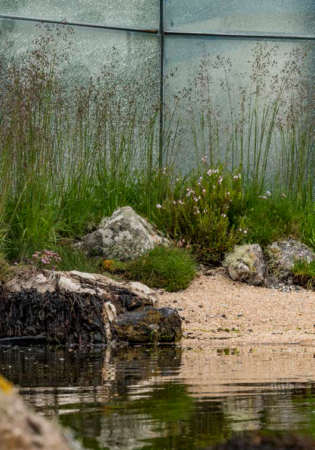

There was quite a bit of interest this year in biodiversity, which is great. Most of these took the shape of a wildflower meadow. How can we build on this message? The Schurmanns garden focused on the littoral zone and highlighted the unnatural disaster which is plastic. There are so many other habitats to inspire a garden: woodland edge gardens, water gardens, wildlife gardens, SUD’s gardens, xerophytic gardens and so on.
Our task as designers should be to educate the public on new ideas in planting, new trends and good horticultural practice. I also believe that given that we are teetering on the edge ecologically we should be taking this message far more seriously with regard to the environment and lead by example.
This is among the reasons that I liked The Cheshire Homes garden by Ruaidhri Bashford so much. The garden featured a handwoven wattle nest, nestled in a giant branch and surrounded by harmonious, textured native planting.
It was calm, beautiful and thoughtfully designed, with a beautifully delivered underlying concept. Everything in the garden was natural and re-usable.
This was the ethos underlying our Cabra Community Garden too, Tóg go bog é. Taking it easy on the environment and the local flora and fauna, when designing a garden. Hawthorn, Mountain Ash, heathers, gorse, bog myrtle and even our native rush making up the core of the planting. Everything was returned or reused upon deconstruction.
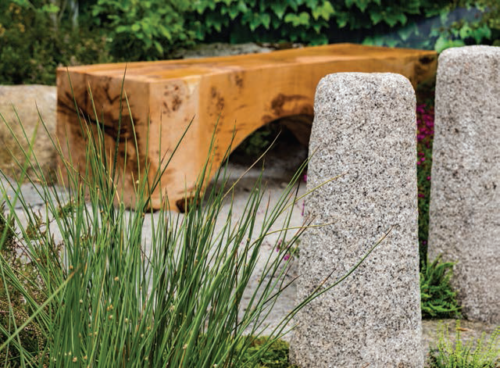

Svaja Vaicula’s small garden for Lidl also demonstrated how you could have a garden for nature and wellbeing in a tiny space, successfully combining water, wildflowers and a green roof. The wildflowers here were particularly beautiful. I think this is one from which the visitor could bring home a lot of ideas.
Wildflowers also featured in the Bee Positive Garden from Fingal County Council. The message here was aimed at children, vital to inspire them at a young age. Bee Positive also demonstrated that you can have both cultivated and wild plants that will serve this purpose.
GARDEN IDEAS FOR THE VISITOR
A garden where the show visitor could be inspired was The Blackwater Gin Garden, designed by Peter Cowell and Monty Richardson. It was constructed from recycled materials in timber and brick and was the kind of garden that most consumers would strongly relate to and enjoy. It was also fun with its barrel hot tub. The design-led planting was strong and bold with tree ferns, Tetrapanax and Rheums. Striking Equisetum caught the eye in the water which surrounded a lovely oasis where you could sit back and enjoy a Gin.
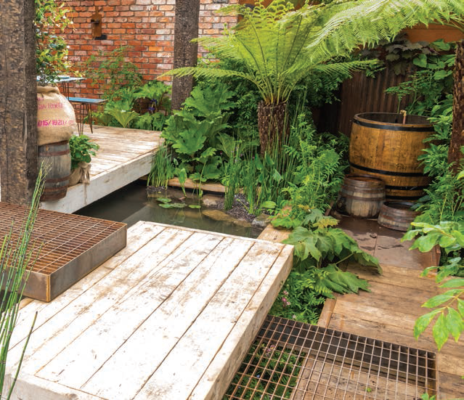

There was much of interest in Kevin Dennis’s FBD Garden which had a planting palette of exotic plants, grasses and perennials such as Cycas revoluta and Osmanthus ilicifolius grown as specimens to give year-round interest. Kevin’s attention to detail was second to none. For a visitor looking for something new, he is always at the forefront with regard to new materials and innovative ways of using them. Porcelain tiles on floors and walls, lighting details, and unique structures that were hard to identify as metal or wood all contributed to something quite unique.
Best in Show went to Alan Rudden’s A matter of Altitude garden. We all need a refuge from the Irish summer and Alan achieved this. Argentina without the sun. I love indoor/ outdoor spaces and it’s something we don’t do enough here and is particularly important given our unpredictable climate. Chunky timber structures with lovely joint details enclosed the outdoor dining area. I also loved the steps down the dining area which were open rebar so that plants could grow underneath. Alan’s garden was very accessible visually with views from different angles and the path at the back was charming and had a lovely atmosphere.
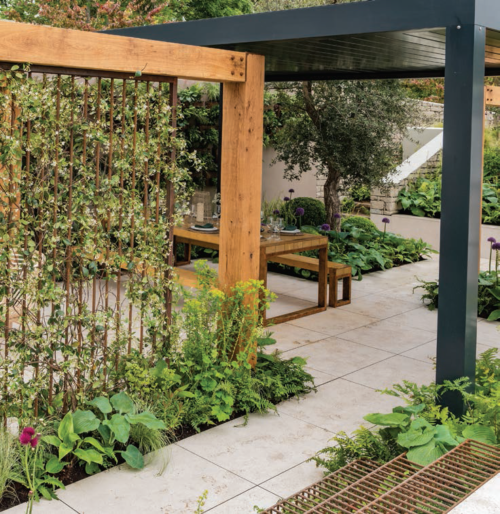

Maeve O’Neill’s large garden was very much in the realm of public space scale, with cutting edge use of steel and stone which won Gold and Best Planting Design. Lovely plantings of Nassela tenuissima and a perfect Japanese maple only hinted at what lay behind the striking granite and corten walls. Here the planting really came into its own with some lovely combinations of Rodgersia and ferns. Some of the plantings could only really be appreciated from within the garden and a pity that these were a little difficult to appreciate from a public perspective.
The Kildare Grower’s garden featured a series of curved walls enclosing an intimate seating area. While novel, the walls obscured much of the planting, and in doing so, undermined the garden’s commercial brief. As a result, it was difficult to appreciate plants and planting. As a key growers group in Ireland, their priority from a marketing perspective is to promote the sale of their member’s plants. To maximise this promotion, they should be not only looking at plants as a decorative element but also a structural one – the roof, the walls, the frame of the garden and the floor. It is an important message to send to the consumer if you are selling plants. No need for concrete walls, when you have a wide choice of plants and the facilities to grow and plan years in advance. It would also send a greener and more environmentally friendly message to the consumer.
Curves and ovals were also a theme this year with James Purdy’s The Healthy Way an arrangement of oval vegetable gardens, reminiscent of the famous allotments at Naerum in Denmark. Nice to see some alternatives to the ubiquitous birch being used here with some nice specimen hawthorn. Hawthorn also featured in Barry Kavanagh’s garden Stolen Land. This year, in general, a greater variety of trees featured in many gardens. Moss too was ubiquitous, featuring on walls, in damp valleys and around rocks and boulders.
Bloom 2019 had many interesting, well-designed and constructed gardens, which were a credit to those behind their creation, but my resounding sense was one of wonder: where does the show go from here? ✽
  She can be contacted via her website at living-landscapes.com |







